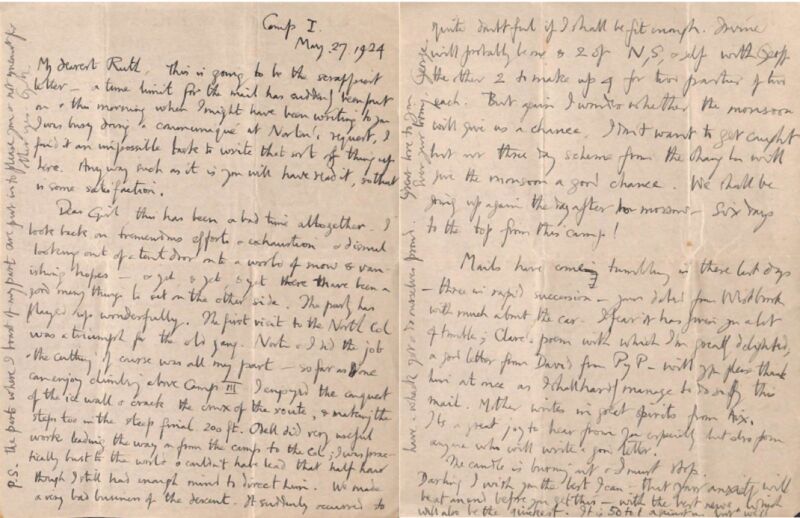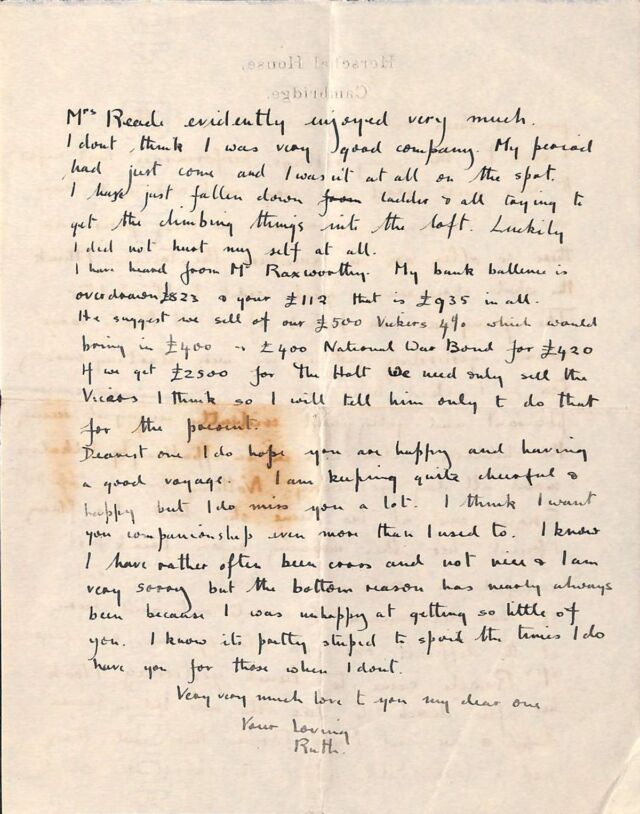“Because it’s there” —
Collection includes three letters found on Mallory’s body in 1999, preserved for 75 years.
Jennifer Ouellette
– Apr 21, 2024 11:01 pm UTC

Enlarge / The final letter from George Mallory from Camp I, Mount Everest, to his wife Ruth Mallory, May 27, 1924.
The Master and Fellows of Magdalene College, Cambridge
In June 1924, a British mountaineer named George Leigh Mallory and a young engineering student named Andrew “Sandy” Irvine set off for the summit of Mount Everest and disappeared—just two casualties of a peak that has claimed over 300 lives to date. Mallory was an alumnus of Magdalene College at the University of Cambridge, which maintains a collection of his personal correspondence, much of it between Mallory and his wife, Ruth. The college has now digitized the entire collection for public access. The letters can be accessed and downloaded here.
“It has been a real pleasure to work with these letters,” said Magdalene College archivist Katy Green. “Whether it’s George’s wife Ruth writing about how she was posting him plum cakes and a grapefruit to the trenches (he said the grapefruit wasn’t ripe enough), or whether it’s his poignant last letter where he says the chances of scaling Everest are ’50 to 1 against us,’ they offer a fascinating insight into the life of this famous Magdalene alumnus.”
As previously reported, Mallory is the man credited with uttering the famous line “because it’s there” in response to a question about why he would risk his life repeatedly to summit Everest. An avid mountaineer, Mallory had already been to the mountain twice before the 1924 expedition: once in 1921 as part of a reconnaissance expedition to produce the first accurate maps of the region and again in 1922—his first serious attempt to summit, although he was forced to turn back on all three attempts. A sudden avalanche killed seven Sherpas on his third try, sparking accusations of poor judgement on Mallory’s part.
Undeterred, Mallory was back in 1924 for the fated Everest expedition that would claim his life at age 37. He aborted his first summit attempt, but on June 4, he and Irvine left Advanced Base Camp (21,330 feet/6,500 meters). They reached Camp 5 on June 6, and Camp 6 the following day, before heading out for the summit on June 8. Team member Noel Odell reported seeing the two men climbing either the First or Second Step around 1 pm before they were “enveloped in a cloud once more.”
Nobody ever saw Mallory and Irvine again, although their spent oxygen tanks were found just below the First Step. Climbers also found Irvine’s ice axe in 1933. Mallory’s body wasn’t found until 1999, when an expedition partially sponsored by Nova and the BBC found the remains on the mountain’s north face, at 26,760 feet (8,157 meters)—just below where Irvine’s axe had been found. The name tags on the clothing read “G. Leigh Mallory.” Personal artifacts confirmed the identity: an altimeter, a pocket knife, snow goggles, a letter, and a bill for climbing equipment from a London supplier. Irvine’s body has yet to be found, despite the best efforts of a 2019 National Geographic expedition, detailed in the riveting 2020 documentary Lost on Everest.

Enlarge / Final page of letter from Ruth Mallory to George Mallory, March 3, 1924.
The Master and Fellows of Magdalene College, Cambridge
The collection makes for some fascinating reading; Mallory led an adventurous life. Among the highlights of the Magdalene College collection is the final letter Mallory wrote to Ruth before attempting his fateful last summit attempt:
“Darling I wish you the best I can—that your anxiety will be at an end before you get this—with the best news. Which will also be the quickest. It is 50 to 1 against us but we’ll have a whack yet & do ourselves proud. Great love to you. Ever your loving, George.”
Three of the letters were found in Mallory’s jacket pocket 75 years after his disappearance when his body was discovered, exceptionally well-preserved. Other letters detailed his experiences at the Battle of the Somme during World War II; his first reconnaissance expedition to Everest; and the aforementioned second Everest expedition in which seven Sherpas were lost. On a lighter note are letters describing his adventures during a 1923 trip to the Prohibition Era US. (He would ask for milk at speakeasies and get whiskey served to him through a secret hatch.) There are also letters from Ruth—including her only surviving letter to Mallory during his Everest explorations—and from Mallory’s sister, Mary Brooke.
>>> Read full article>>>
Copyright for syndicated content belongs to the linked Source : Ars Technica – https://arstechnica.com/?p=2018634































